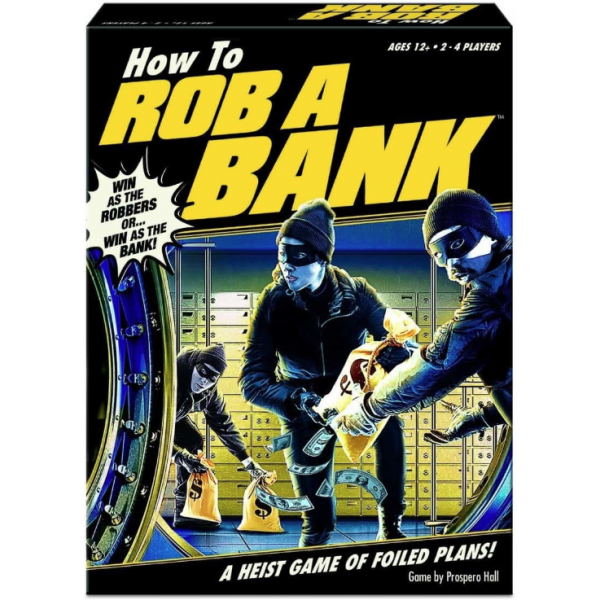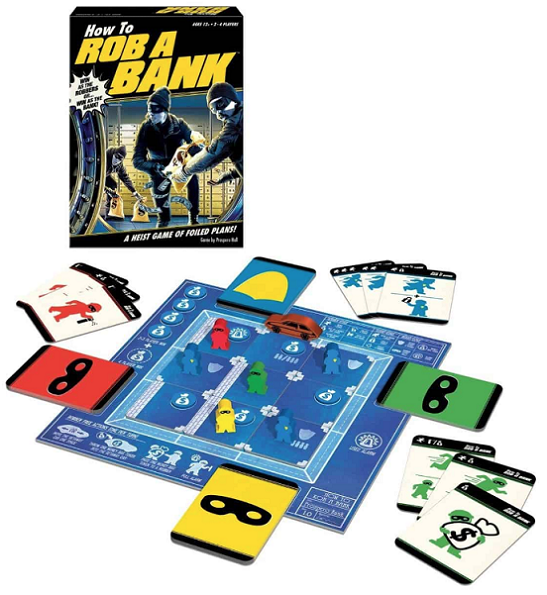Learn How to Rob a Bank (or Prevent a Robbery) in This Casual Heist Game

One player takes on the role of the bank while the others don robber masks and attempt to get away with the loot!
Published by Big G Creative, How to Rob a Bank is an action programming game of bluffing and memory elements.
Gameplay
One player plays as the guards while each other player will control a robber (in a two player game the robber player will control two thieves). You place the board in the center of the table, shuffle the nine room tiles, and place them on the board in a three-by-three grid. You then place a token on each room tile which has a token symbol (money bags and one alarm). A guard is placed on each tile that shows a guard symbol, and the thieves are placed on the tile with the thief symbol. Finally, the getaway car is placed along the edge of the board opposite to where the thieves start. The board is rebuilt at the start of each round.
The game is played over three rounds. If the thieves manage to get four money bag tokens scored (or five in a four-player game), they win the game. If the guard prevents them from doing so, she wins the game at the end of the third round.
At the start of the round, each player takes a guard or robber deck of cards, depending on their role, then shuffles it, draws seven, and sets the others aside. Players then start the planning phase.
During the planning phase, each player takes a turn placing one card face-up in front of themselves, starting with the guard. You continue to do this until each player has played five cards; placing each new card on top of the last one you played so as to hide it. The robbers are allowed to talk among themselves but should bear in mind that the guard can hear them.
Once the planning phase is over, you flip over the cards you played (being sure to keep them in the same order in which they were played), and then players take turns playing the top card of their stacks, again starting with the guard player, and performing the actions shown on the card if possible.
Actions include moving a space, incapacitating an opponent’s pawn, and locking or unlocking a token. Robbers can also use a vent action to move to any room tile, and can pick up a money bag token. A money bag token cannot be picked up while it is locked.
When a pawn is incapacitated, it is set on its side. When a robber is incapacitated, his player must discard the next card in his stack and skip his turn in order to stand the pawn back up. The guard player can choose to do this as long as only one of her guards is incapacitated — but must do so if all of them are. The guard player can also spread the actions on her card across all her guards, while the robber card actions must be performed by the pawn belonging to the person who played the card.
The robbers also have four free actions they can take. They can move the getaway car one space around the board; if they are on a tile adjacent to the car they can throw the money bag into it, thereby scoring it (they cannot do this if there is a conscious guard on the same tile); they can pass a money bag token to another player; and once per round if on the alarm tile and the alarm is not locked they can pull it (which moves all guards onto the alarm tile).
Once everyone has played all five cards the round is over. Any money bag tokens that the robbers are currently holding but have not yet scored are discarded.

Review
How to Rob a Bank is light, easy, and simple to play. It’s not too complicated for families but can also be enjoyed by adult game groups. It works well both as a team game or with only two players. In fact, it’s at its best with two players, as the robber controls two thieves and isn’t going to miss his turn entirely burning a card to revive his only pawn. Both roles are enjoyable to manage and the game combines several fun elements into a satisfying whole.
The card abilities are flexible, so that even if you do have to burn a card to revive your robber or guard, that won’t make your remaining cards useless, you just have to adapt your plan. This makes the memory element of the game really shine through as you try to remember not only what cards you played, but also what cards your opponent played. While familiarity with the game will enable you to plan better and pull off better moves, the game doesn’t penalize you too severally if a card play doesn’t turn out the way you expected it to.
There is also some bluffing involved in the game, from what cards you play in what order during the planning phase, to trying to mislead your opponent as to what you plan to do. Of course, the best laid plans can still go awry based on the other players, which lends a fun element of surprise and chaos to the gameplay. It’s also fun that there is some variation between rounds — from the cards you have available to choose from, to the layout of the bank.
Most of the components are attractive but a bit lightweight, and the cards could be made from a better quality material. However, the pawns and car tokens are a lot of fun to play with.
How to Rob a Bank isn’t highly strategic or complex. It’s a light, casual, family-friendly board game full of unexpected twists in the heist and plenty of opportunities to pull off a clever move.
Pros: Strong two player game, easy to teach and fast to play, memory elements blend well with unexpected shifts in your plan
Cons: Component quality could be improved, a robber player may lose their turn entirely in a three-to-four player game
Disclosure: we received a complimentary review copy of this game.







